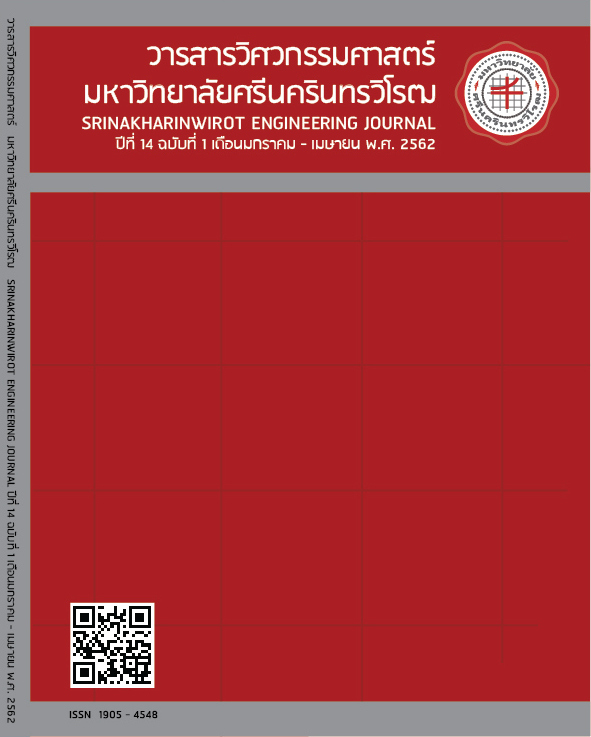Grey Relational Analysis for Optimal Condition of Biodiesel Production Process from Fish Entrails
Main Article Content
Abstract
This research article aimed to investigate an optimal condition of biodiesel production from fish entrails oil. The grey relational analysis was used to find the suitable condition together with many objectives for efficient biodiesel sufficiently in agricultural engine application. Transesterification reaction was applied in the biodiesel production experiment. The four factors of biodiesel synthesis were studied as follows; ratio of methanol to potassium hydroxide, stirring speed, reaction time and reaction temperature. The three responses were free fatty acid quantity (FFA), sulfated ash content and flash point. The results exhibited that the best condition of the biodiesel production is 3.0:130, 500 rpm, 60 minute and 60 °C for volume per weight ratio of methanol to potassium hydroxide, stirring speed, reaction time and reaction temperature, respectively. Hence, the biodiesel from this optimal condition showed 1.60 mg KOH/g Oil of FFA, 0.11% m/m of sulfated ash content and 162 °C of flash point. Moreover, these results were consistent with the special standard level of department of energy business. Therefore, the prepared biodiesel was applied in the agricultural engine after that the engine operated continuously with no shutdown or stumble.
Article Details
Copyright belongs to Srinakharinwirot University Engineering Journal
References
[2] กรมพัฒนาพลังงานทดแทนและอนุรักษ์พลังงาน. (2561, ธันวาคม 1). ข้อมูลการใช้ไบโอดีเซลประจำเดือน ปี 2561. [Online].Available: https://www.dede.go.th/ewt_news.php?nid=47882&filename=Biodiesel.
[3] H. Omidvarborna, A. Kumar and D. Kim, “NOx emissions from lowtemperature combustion of biodiesel,” Fuel Process Technol, vol. 140, pp. 113-118, 2015.
[4] W. Roschata, T. Siritanon, T. Kaewpuang, B. Yoosuk and V. Promarak, “Economical and green biodiesel production process using river snail shells-derived heterogeneous catalyst and co-solvent method”, Bioresource Technology, vol. 209, pp. 343-350, 2016.
[5] I. Atadashi Musa, “The effects of alcohol to oil molar ratios and the type of alcohol on biodiesel production using transesterification process”. Egyptian Journal of Petroleum, vol. 25, no.11, pp. 21-31, 2016.
[6] M. Babaki, M. Yousefi, Z. Habibi, M. Mohammadi and J. Brask, “Effect of water, organic solvent and adsorbent contents on production of biodiesel fuel from canola oil catalyzed by various lipases immobilized on epoxy-functionalized silica as low cost biocatalyst,” Journal of Molecular Catalysis B: Enzymatic, vol. 120, pp. 93-99, 2015.
[7] รุ่งทิพย์ ชัยเดช, “การผลิตไบโอดีเซลแบบต่อเนื่องจากน้ำมันทอดใช้แล้วโดยใช้ตัวเร่งปฏิกริยาโซเดียมเมทอกไซด์,” วิทยานิพนธ์ สาขาวิศวกรรมเคมี มหาวิทยาลัยสงขลานครินทร์, สงขลา, 2557.
[8] วุฒิชัย รสชาติ และ จาณียา ขันชะลี, “กระบวนการผลิตไบโอดีเซลจากน้ํามันปาล์มดิบโดยใช้แคลเซียมออกไซด์จากเปลือกหอยแครงเป็นตัวเร่งปฏิกิริยาที่ประหยัดและเป็นมิตรกับสิ่งแวดล้อม,” วารสารวิทยาศาสตร์และเทคโนโลยี มหาวิทยาลัยอุบลราชธานี, ปีที่ 20, ฉบับที่ 1, หน้า 94-106, 2561.
[9] วุฒิชัย รสชาติ, เทอดเกียรติ แก้วพวง, บุญญาวัณย์ อยู่สุข, และ วินิช พรหมอารักษ์, “การผลิตน้ำมันไบโอดีเซลจากน้ำมันใช้แล้วที่อุณหภูมิห้องโดยใช้แคลเซียมออกไซด์เป็นตัวเร่งปฏิกริยา,” ใน การประชุมสัมนาเชิงวิชาการรูปแบบพลังงานทดแทนสู่ชุมชนแห่งประเทศไทย ครั้งที่ 7., 12-14 พฤศจิกายน 2557.
[10] W. Asri Kawentar and A. Budiman, “Synthesis of Biodiesel from Second-Used Cooking Oil,” Energy Procedia, vol. 32, pp. 190-199, 2013.
[11] N. Banerjee, R. Ramakrishnan and T. Jash, “Biodiesel production from used vegetable oil collected from shops selling fritters in Kolkata,” Energy Procedia, vol. 54, pp. 161 – 165, 2014.
[12] ปัญญา มณีจักร์, “การผลิตไบโอดีเซลจากน้ำมันพืชที่ใช้แล้วโดยใช้ตัวเร่งปฏิกิริยาเบสแก่ร่วมกับถ่านกัมมันต์,” การประชุมวิชาการระดับชาติ มหาวิทยาลัยรังสิต ประจำปี 2558, 28 มกราคม 2558.
[13] M. Charoenchaitrakool and J. Thienmethangkoon, “Statistical optimization for biodiesel production from waste frying oil through two-step catalyzed process,” Fuel Processing Technology, vol. 92, no. 11, pp. 112-118, 2011.
[14] J. Escobar, E. Lora, O. Venturini, E. Yanez, E. Castillo and O. Almazan, “Biofuels: Environment, technology and food security,” Renewable & Sustainable Energy Reviews, vol. 13, no. 16-17, pp. 1275-1287, 2009.
[15] S. Martinez, R. Romero, R. Natividad and J. Gonzalez, “Optimization of biodiesel production from sunflower oil by transesterification using Na2O/NaX and methanol,” Catalysis Today, vol. 220, no. 222, pp. 12-20, 2014.
[16] LLC for the National Biodiesel Board Centrec Consulting Group. (2014, September 10) “Biodiesel demand for animal fat and tallow generates an additonal revenue stream for the livestock industry”. [Online]. Available:https://biodiesel.org/docs/default-source/news---supporting-files/animal-fats-and-tallow-bd-demand-impact-report.pdf?sfvrsn=2
[17] M. da Cunha, L. Krause, M. Moraes, C. Faccini, R. Jacques, S. Almeida, M. Rodrigues and E. Caramão, “Beef tallow biodiesel produced in a pilot scale,” Fuel Processing Technology, vol. 90, no.14, pp. 570-575, 2009.
[18] D. Leung, X. Wu and M. Leung, “A review on biodiesel production using catalyzed transesterification,” Applied Energy. Vol. 87 no. 14, pp. 1083-1095, 2010.
[19] อุสารัตน์ ถาวรชัยสิทธิ์, ชลาลัย จันทร์ยอด, ปัทมาพร อินทร์พรหม และ วัฒนฤดี อึ้งมงคลชัย, “การผลิตไบโอดีเซลจากไขมันวัวด้วยปฏิกิริยาทรานส์เอสเทอริฟิเคชันโดยใช้ตัวเร่งปฏิกิริยาชนิดเบส,” วารสารวิทยาศาสตร์ลาดกระบัง, เล่มที่ 25, ฉบับที่ 11, หน้า 89-98, 2559.
[20] A. Acır , M. Emin Canlı, İ. Ata and R. Çakıroglu, “Parametric optimization of energy and exergy analyses of a novel solar air heater with grey relational analysis,” Applied Thermal Engineering, vol. 122, pp. 330-338, 2017.
[21] F. Ma, L. Clements and M. Hanna, “The effects of catalyst, free fatty acids and water on transesterification of beef tallow,” Transactions of the ASAE, vol. 41, pp. 1261-1264, 1998.
[22] K. Thiruvengadaravi, J. Nandagopal, V. Sathya Selva Bala , S. Dinesh Kirupha, P. Vijayalakshmi and S. Sivanesan, “Kinetic study of the esterification of free fatty acids in non-edible Pongamia pinnata oil using acid catalyst,” Indian Journal of Science and Technology, vol. 2, pp. 20–24., 2009.
[23] M. Berrios, J. Siles, M. Martin and A. Martin, “A kinetic study of the esterification of free fatty acids (FFA) in sunflower oil,” Fuel, vol. 86, pp. 2383–2388., 2007.
[24] สุภกร บุญยืน , สมลักษณ์ เรืองสุทธินฤภาพ , จิรดา สิงขรรัตน์ และ นภัทร ทวีกาญจน์, “อิทธิพลของกรดไขมันอิสระ ต่อการผลิตไบโอดีเซล,” วารสารวิทยาศาสตร์และเทคโนโลยี, เล่มที่ 18, ฉบับที่12, หน้า 37-41, 2553.


